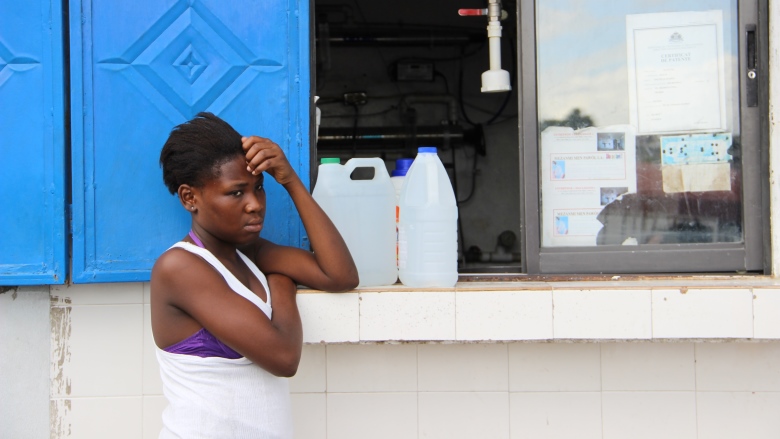Challenge
In October 2010, just 10 months after a deadly earthquake, the first case of cholera was confirmed in Haiti. Living conditions in the country were particularly poor. At the time it was estimated that about 38 percent of Haitian families lacked access to safe drinking water and only 24 percent had access to proper sanitation. Some families had little or no access to health care and had limited knowledge of basic health and hygiene practices. As a result, in less than a month, cholera had spread throughout the country. The epidemic stressed already weak health system beyond its capacity. Many facilities operated without running water, beds or even chairs for patients. Health workers lacked experience managing cholera cases. In many cases, there simply were not sufficient numbers of health staff to treat the large influx of patients.
Solution
Shortly after the outbreak, the World Bank moved quickly and urgently and funded the Cholera Emergency Response Project to prevent new cases, provide quality treatment to infected patients, and strengthen the government’s capacity to respond rapidly to emergencies. It targeted six departments (Centre, Artibonite, Sud, Sud-est, Grand Anse, Nippes) and parts of Port-au-Prince. It supported implementation and rollout of emergency activities by non-governmental organizations (NGOs) and the public sector as well as developing a joint Health-Water and Sanitation World Bank approach to waterborne diseases.
Results
As the government’s capacity improved, departmental health authorities developed clear and prioritized plans for cholera control and increasingly contributed to the large-scale prevention and treatment efforts in these departments. Three years after the outbreak, the integration process meant the transition from previously stand-alone cholera treatment sites (usually tents) into the existing health facilities. This integration helped sustaining the control of the epidemic while reducing costs and, thus, made possible to have a more sustainable solution for cholera control. In addition, thanks to this Project and Bank’s engagement in cholera two conferences were organized in April and October 2014. These conferences brought best global experts and donors together and developed a joint Health-Water and Sanitation approach to waterborne diseases, which is currently under implementation.
The project focused on (i) increasing knowledge of cholera early warning symptoms and prevention steps, (ii) maintaining or expanding access to improved water sources, and (iii) strengthening the government’s institutional capacity to respond to outbreaks. Between 2010 and 2013 the cholera case fatality rate decreased significantly in project areas (1.8 percentage points) when compared in the country as a whole (1.2 percentage points).The project benefited over 3 million people and institutional capacity was clearly strengthened.
The project also helped to achieve the following results:
- Training of 5571 medical personnel and community workers.
- Distribution of water treatment products and soap to over 850,000 people.
- Rehabilitation of 115 latrines, seven water pumps and 20 water fountains.
- Health education and hygiene promotion for residents in 4,447 communities.
- Equipment of 256 health centers and posts, treatment and chlorination centers and units, and oral rehydration posts with necessary supplies.
- An increase in the percentage of citizens who could recognize cholera early warning symptoms (from 64 percent in 2011 to 82 percent in 2013).
- Development of six department cholera management plans by the Ministry of Public Health and Population (MSPP) and the Ministry of Water and Sanitation (DINEPA).
- Recruitment and hiring of one national focal point and six departmental cholera coordinators.
Bank Group Contribution
The Bank’s response to the Haitian government’s call to the international community for support was its first operation in the health sector in over a decade. The Bank complemented this support with further assistance provided by the Global Facility for Disaster Reduction and Recovery.
The Project was funded by an emergency reconstruction IDA grant of US$15 million equivalent over a period of implementation two and a half years.
Partners
The Bank was part of a strong partnership among key development partners in Haiti’s health, social protection, and water and sanitation sectors. The Bank project team participated regularly in meetings with partners to coordinate project implementation and support plans, identify lessons learned and opportunities, and strategize future actions. These partners include: the US Government Center for Disease Control (CDC), US Agency for International Development (USAID), United Nations Children’s Fund (UNICEF), the Pan-American Health Organization (PAHO), the Inter-American Development Bank (IADB), and Médecins Sans Frontières (MSF). Joint field supervision missions were regularly carried out with the CDC. The Bank was also an active member of The Regional Coalition to Eliminate Cholera in Hispaniola.
Moving Forward
The Bank, as a member of the Regional Coalition on Water and Sanitation for the Elimination of Cholera in Hispaniola, brings technical expertise and mobilizes resources to support the 10-year National Plan for the Elimination of Cholera in Haiti. In addition, the Bank has approved a project aimed at Improving Maternal and Child Health through Integrated Social Services through which US$20 million will be used to support the National Plan for the Elimination of Cholera. The Bank has also approved a new water and sanitation operation of US$50 million which will support a number of the most affected communes by cholera.
Beneficiaries
Ricarmel Princivilma, 42, mother of four children, lives in a small village in Haiti’s Centre Department. With the complications of vomiting and diarrhea, she had to spend two days in a clinic. Ricarmel confessed that the family was defecating outside near the house. In addition, the family had been drinking water from an unprotected source. “With the help of the project brigadier, my house has been disinfected. I got a package of tablets for the treatment of water and advice on good hygiene practices that helped the rest of the family to escape from cholera,” she remarked.

